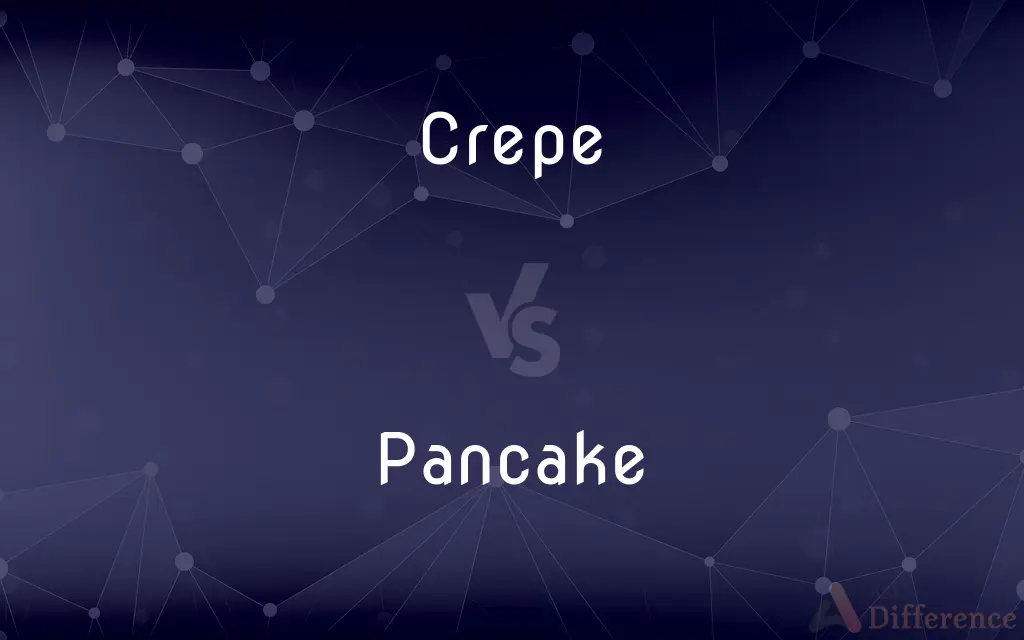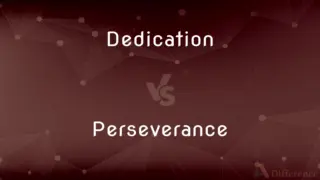Crepe vs. Pancake — What's the Difference?
By Tayyaba Rehman & Maham Liaqat — Updated on March 30, 2024
A crepe is a thin, delicate pancake of French origin, made with a liquid batter, often served with sweet or savory fillings, whereas a pancake is thicker, fluffier, and typically served with syrup or butter.

Difference Between Crepe and Pancake
Table of Contents
ADVERTISEMENT
Key Differences
Crepe batter is made from a mixture of flour, milk, eggs, and butter, resulting in a thin, silky texture that is cooked on a hot surface to achieve a light, almost crispy edge. The batter for crepes is usually very liquid, allowing it to spread thinly and evenly across the cooking surface. Pancakes, in contrast, include a leavening agent such as baking powder, which gives them a thicker and fluffier texture. The batter for pancakes is thicker, leading to a rise during cooking that creates a soft, spongy texture.
Crepe recipes often call for resting the batter to allow the flour to hydrate and the gluten to relax, resulting in a delicate and tender texture. Pancakes, meanwhile, can be made quickly and cooked immediately after mixing the ingredients, making them a popular choice for a hearty breakfast.
Crepes are versatile in their serving options, often rolled or folded with a variety of fillings ranging from simple sugar and lemon juice to complex savory options like ham and cheese or spinach and ricotta. Pancakes are typically served stacked, topped with butter, maple syrup, fruit, or whipped cream, highlighting their fluffy texture.
The cooking technique for crepes requires a hot, flat surface and a skillful hand to spread the batter thinly, using a specific crepe spreader or tilting the pan. Pancakes are simpler to prepare, spooned onto a hot griddle or pan and flipped once bubbles form on the surface, indicating readiness to be turned.
Crepes are celebrated for their finesse and elegance, often associated with sophisticated desserts or meals, especially in French cuisine. Pancakes have a more homely appeal, associated with comfort food and family-friendly breakfasts, widely enjoyed in many cultures with variations in ingredients and toppings.
ADVERTISEMENT
Comparison Chart
Batter Consistency
Very liquid, no leavening agent
Thicker, contains leavening agent
Texture
Thin and delicate
Thick and fluffy
Serving Style
Rolled or folded with fillings
Stacked with toppings
Cooking Technique
Spread thinly on a hot surface
Spooned and flipped on a griddle
Cuisine Origin
French
Various, including American
Preparation
Batter often rested
Can be cooked immediately
Fillings and Toppings
Sweet or savory fillings
Syrup, butter, fruit, or whipped cream
Cultural Association
Sophistication and finesse
Comfort food and family breakfasts
Compare with Definitions
Crepe
Versatile in serving options, accommodating both sweet and savory ingredients.
He prefers savory crepes stuffed with ham and Gruyère cheese.
Pancake
Served stacked and topped with syrup, butter, or fruit.
Their breakfast special includes pancakes topped with fresh blueberries and whipped cream.
Crepe
Often associated with elegant desserts or sophisticated meals.
They served chocolate crepes for dessert at the wedding.
Pancake
Represents comfort food, ideal for a hearty breakfast.
Nothing beats the comfort of warm pancakes on a cold morning.
Crepe
Known for its delicate, almost crispy edges and tender center.
The crepes had perfectly crispy edges, just like at a Parisian café.
Pancake
The batter can be made quickly and cooked immediately.
Making pancakes is easy; just mix the ingredients and cook them right away.
Crepe
A thin French pancake with no leavening agent, served with a variety of fillings.
For brunch, she prepared sweet crepes filled with Nutella and strawberries.
Pancake
A staple breakfast food in many cultures, often enjoyed with family.
Pancake day is a family tradition where everyone helps in the kitchen.
Crepe
Requires a liquid batter that is thinly spread on the cooking surface.
Making crepes involves spreading the batter thinly to achieve the right texture.
Pancake
A thick, fluffy cake cooked on a griddle or frying pan, made from a batter that includes a leavening agent.
Sunday mornings are for homemade pancakes with maple syrup.
Crepe
A light, thin fabric with a wrinkled surface
A crêpe bandage
Pancake
A pancake (or hotcake, griddlecake, or flapjack, not to be confused with oat bar flapjacks) is a flat cake, often thin and round, prepared from a starch-based batter that may contain eggs, milk and butter and cooked on a hot surface such as a griddle or frying pan, often frying with oil or butter. Archaeological evidence suggests that pancakes were probably the earliest and most widespread cereal food eaten in prehistoric societies.The pancake's shape and structure varies worldwide.
Crepe
A thin pancake.
Pancake
A thin, flat cake of batter, fried on both sides in a pan and typically rolled up with a sweet or savoury filling
Crispy pancakes filled with cheese
Pancake batter
Crepe
A light soft thin fabric of silk, cotton, wool, or another fiber, with a crinkled surface. Also called crape.
Pancake
Make-up consisting of a flat solid layer of compressed powder, used especially in the theatre.
Crepe
See crape.
Pancake
(with reference to an aircraft) make or cause to make a pancake landing
The plane landed, pancaking down on the runway
Crepe
Crepe paper.
Pancake
Flatten or become flattened
Hurley's car was pancaked
Crepe
Crepe rubber.
Pancake
A thin cake made of batter that is poured onto a hot greased surface and cooked on both sides until brown. Also called flannel cake, flapjack, griddle cake, hotcake; also called regionally battercake.
Crepe
(also krĕp) A very thin pancake, often wrapped around a sweet or savory filling.
Pancake
To cause (an aircraft) to make a pancake landing.
Crepe
A flat round pancake-like pastry from Lower Brittany, made with wheat.
Pancake
To make a pancake landing.
Crepe
A soft thin light fabric with a crinkled surface.
Pancake
To fall flat to the ground with great force, especially to collapse in such a way that higher floors or structures fall directly on the ones beneath.
Crepe
Crepe paper; thin, crinkled tissue paper.
Pancake
A thin batter cake fried in a pan or on a griddle in oil or butter; in particular:
Crepe
Rubber in sheets, used especially for shoe soles.
The policeman wore crepe-soled shoes.
Pancake
In England, an often unleavened cake similar to a crepe.
Crepe
(Ireland) A death notice printed on white card with a background of black crepe paper or cloth, placed on the door of a residence or business.
Pancake
In the US (and e.g. Scotland), a leavened, thicker, fluffier cake.
Crepe
(transitive) To crease (paper) in such a way to make it look like crepe paper
Pancake
(theater) A kind of makeup, consisting of a thick layer of a compressed powder.
Crepe
(transitive) To frizz (the hair).
Pancake
(juggling) A type of throw, usually with a ring where the prop is thrown in such a way that it rotates round an axis of the diameter of the prop.
Crepe
Same as Crape.
Pancake
Anything very thin and flat.
Pancake lens
Crepe
Any of various crapelike fabrics, whether crinkled or not.
Pancake
Composite leather made of scraps, glue and board, by extension of (4), material originally used for insoles, but later used also for heels and even soles.
Crepe
A small thin pancake.
Pancake
A box on which an actor stands to make them appear taller.
Crepe
Paper with a finely crinkle texture, usually sold in rolls of 2-3 inches width; crepe paper; - it is usually colored brightly and used for decoration.
Pancake
(volleyball) A defensive play in which the ball bounces off the top of a hand that has been pressed flat against the floor.
Crepe
Paper with a crinkled texture; usually colored and used for decorations
Pancake
(intransitive) To make a pancake landing.
Crepe
Small very thin pancake
Pancake
To collapse one floor after another.
Crepe
A soft thin light fabric with a crinkled surface
Pancake
(transitive) To flatten violently.
Crepe
Cover or drape with crape;
Crape the mirror
Pancake
A thin cake of batter fried in a pan or on a griddle; a griddlecake; a flapjack.
Pancake
A flat cake of thin batter fried on both sides on a griddle
Common Curiosities
What makes crepes different from pancakes in texture?
Crepes are thin and delicate due to a liquid batter without leavening agents, while pancakes are thicker and fluffier thanks to the inclusion of baking powder.
Can you use pancake batter to make crepes?
Pancake batter is too thick for crepes; crepe batter needs to be thinner and without a leavening agent for the right consistency.
Is it difficult to flip a crepe?
Flipping crepes requires some practice due to their delicate nature, but with the right technique, it becomes an easy task.
Can pancakes be filled like crepes?
While pancakes are not typically filled like crepes due to their thickness, they can be served with various toppings or sandwiched with fillings.
What is the best way to serve pancakes?
Pancakes are best served stacked with toppings like syrup, butter, fruit, or whipped cream for added flavor.
Why do crepe recipes often recommend resting the batter?
Resting allows the flour to hydrate and the gluten to relax, resulting in a more tender and cohesive batter.
Are crepes healthier than pancakes?
Crepes can be lighter and less caloric due to their thinness, but the healthiness depends on the fillings or toppings used.
Do crepes and pancakes originate from the same cuisine?
Crepes are of French origin, while pancakes have variations in many cultures, including American.
Can both crepes and pancakes be made ahead of time?
Yes, both can be made ahead and reheated, though crepes are best enjoyed fresh for optimal texture.
What are some popular crepe fillings?
Popular fillings include Nutella, strawberries, bananas, ham, cheese, and spinach.
Share Your Discovery

Previous Comparison
Fact vs. Truth
Next Comparison
Dedication vs. PerseveranceAuthor Spotlight
Written by
Tayyaba RehmanTayyaba Rehman is a distinguished writer, currently serving as a primary contributor to askdifference.com. As a researcher in semantics and etymology, Tayyaba's passion for the complexity of languages and their distinctions has found a perfect home on the platform. Tayyaba delves into the intricacies of language, distinguishing between commonly confused words and phrases, thereby providing clarity for readers worldwide.
Co-written by
Maham Liaqat













































